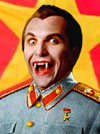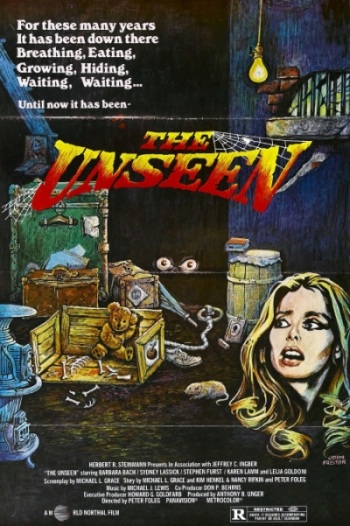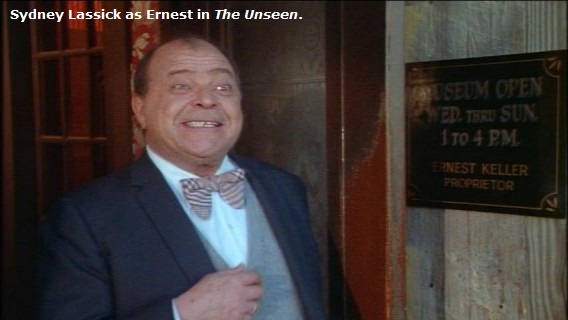|
The Unseen Film review by Thomas M. Sipos |
|
MENU Books Horror Film Festivals and Awards
Pursuits
Blogs Horror Film Festivals and Awards
Other
|
The Unseen (1980, dir: Peter Foleg; scp: Michael L. Grace; cast: Barbara Bach, Sydney Lassick, Stephen Furst, Karen Lamm, Lelia Goldoni, Doug Barr, Lois Young).
Count me among those defenders. And while you're counting, include Michael Weldon (The Psychotronic Encyclopedia of Film): "underrated and perverse"; Chas Balum (Deep Red): "Slick, dirty little film nonetheless holds a degree of interest for the horror-sleaze crowd."; and John Stanley (Creature Features): "takes one of the hoariest cliches of horror movies -- the animalistic 'unseen' entity living in the cellar -- and gives it a new sense of mystery, even compassion." The Unseen is another of my personal favorites, outstanding on every level. Yes, the story is basic Horror Film 101. Three TV newsgals drive to Solvang, California to do a puff piece on a folk festival. All the local hotels are booked so, while searching for a hotel outside of town, they stumble upon one run by Ernest Keller (Sydney Lassick). Turns out the hotel is a museum. No matter. Ernest invites the newsgals to stay at his house, with him and his wife, Virginia (Lelia Goldoni). Unbeknownst to the newsgals, husband and wife are also brother and sister. And lurking in the basement, crawling through the air ducts, is the spawn of their unholy union ... unseen! Well, you'll see him eventually. But before you do, the body count mounts! (You know how those mutant spawn-of-incest retards get when they see nekkid women passing by their air ducts.) Actually, the body count doesn't mount by all that much. There are only three newsgals, after all. But there's enough in The Unseen to make up for the low score. Yes, The Unseen's premise and story are easy to mock. They sound so formulaic. Yet the film's execution raises it to a masterpiece of the formula. Barbara Bach (still the best Bond girl -- The Spy Who Loved Me) is the lead newsgal, Jennifer Fast. Granted, Bach's acting range is limited (Leonard Maltin once opined: "Bach does her usual walk-through."), but she is stunning to behold. And she improves in the final half hour, when all that's required is to scream and cower. Bach can deliver if a script is within her range; she was dead-on as the smart, stoic Soviet spy in the Bond film. Fortunately for Bach, she spends the first hour surrounded by poor performers, so she looks fine by comparison. Bach's love interest, Tony (Doug Barr), is the sort of jejune Ken doll that Mary Richards always dated on The Mary Tyler Moore Show. The other two newsgals, Karen Lamm and Lois Young, are no better.
As is often the case in horror, it's the villains that show range, depth, and emotional strength. Sydney Lassick is wonderfully creepy as Ernest. Smarmy with the newsgals, babbling giddy nonsense. His unstable volatility with his family pivots from giddy to cold to cruel to violently hysterical. Dark emotions simmer beneath Lassick's assumed demeanors, erupting when provoked. Lelia Goldoni's Virginia is an aging mouse of a woman. Yet she too can erupt into hysteria, or show tender compassion to her mutant son. But it is Stephen Furst (Animal House) who shines as Junior Keller ... the unseen. Weldon describes Junior as a "murderous, retarded, overweight, full- grown baby." That's kinda what Junior looks like, but not really what he is. Having seen The Unseen a dozen or so times, I suspect he kills the women by accident. He merely wants a closer look (at Lamm's golden hair, for instance), and pulls too hard. A child who doesn't know his own strength. And he's not a "full-grown baby," he just looks like one because he's fat, dressed in soiled diaper-like rags, and he can't talk. He can only grunt.
Okay actors. Here's an assignment: Portray a sympathetic mutant retard killer, while wearing soiled diaper-like rags, in makeup that makes you look like some ugly incestuous spawn from Deliverance. And all you're allowed to do is grunt. Grunt and stomp and pound and grunt. And oh yeah, try and be nuanced and subtle. Furst does it. His Junior is ugly and frightening, yet we detect his motivations beneath his grunting and stomping. His frustrated ineffectual attempts to communicate with Bach and recruit her for his playmate. His love for mom. His fear, then anger, at dad. However repulsive and scary and unsympathetic Junior initially appears, his demise is poignant. I hesitate to equate Furst's Junior with Karloff's Monster, but I also hesitate to dismiss the comparison out of hand. The script is tightly structured, its elements falling neatly together despite more complexity than cursorily appears. You can view The Unseen many times, and still discover new things to appreciate. E. Michael Jones, in his Monsters From the Id: The Rise of Horror in Fiction and Film, interprets all horror as a monster (nemesis) spawned by a transgression of God's (sexual) moral code. The Unseen easily allows for that interpretation. Junior is born of incest, most likely rape. Bach contemplates an abortion because she is not ready to marry Barr until he matures. She is rescued moments after Barr returns (having changed his mind), thereby affirming their mutual love (and by implication, obviating the need for an abortion). Jones is a social conservative. But a left-feminist could interpret The Unseen from an opposing view: as a condemnation of patriarchy. Junior is (most likely) the result of rape. Goldoni's father had wanted Junior aborted, so perhaps it was Goldoni's "choice" to birth Junior (although maybe it was the domineering Lassick's choice). Lassick oppresses both his wife/sister and son, until her self-liberation. It is Goldoni who saves Bach (Barr tries, but fails). Both interpretations are justifiable. Indeed, the deceptively simple story elements mesh so nicely, one could fill a lecture hall with politically diverse academics and spend a semester conferencing on The Unseen's "real meaning." Don't forget to invite some Freudians. Lassick's dad tried to castrate him for raping sis. So Lassick killed dad, then married sis and had Junior. The mummified dad is kept in the museum (shades of Norman Bates). Lassick's memories of that fateful day is a nice example of pragmatic aesthetics. The actor playing the father is not present, just his voiceover within Lassick's guilty conscience. It's not only cheaper to film with one less actor, it works within the story. Lassick sits on a chair, talking to a voiceover of his dad. The camera pans and crosscuts as dad's "character" is created by mementos, voiceover, and Lassick's frightened responses. (By pragmatic aesthetics, I mean when a filmmaker puts budgetary production compromises to aesthetic effect. Forced to compromise on location, lighting, whatever, the filmmaker uses that limitation in a way that enhances the theme or story. I first used the term in my essay, "The Pragmatic Aesthetics of Low-Budget Horror Cinema," published under another title in Midnight Marquee #60. For a fuller explanation, see my book, Horror Film Aesthetics.)
Mise-en-scene, lighting, and editing are all stellar in The Unseen, even if at times obvious and by-the-book. A sudden rainstorm when the story darkens. The crosscutting between Goldoni's killing of a chicken and Junior's killing of a woman. The flickering electrical light upon our first seeing "the unseen" Junior. The quickening cross-cutting about the museum (and cat) leading to a slow revelation of the mummy. The murky atmospheric lighting in the museum in contrast to the cheerful brightness of Solvang. Solvang is a nice touch. Low-budget horror films are forever seeking ways to separate themselves from the pack. Solvang is an actual town founded along old Dutch lines, with Dutch folk festivals and all. This locale, while not integral to the story, provides a fresh backdrop to horror. I told you The Unseen succeeds on every level. Yes, Danny Peary, count me as one of the film's defenders. Review copyright by Thomas M. Sipos
|
"Communist Vampires" and "CommunistVampires.com" trademarks are currently unregistered, but pending registration upon need for protection against improper use. The idea of marketing these terms as a commodity is a protected idea under the Lanham Act. 15 U.S.C. s 1114(1) (1994) (defining a trademark infringement claim when the plaintiff has a registered mark); 15 U.S.C. s 1125(a) (1994) (defining an action for unfair competition in the context of trademark infringement when the plaintiff holds an unregistered mark).



